Hidden Similarity Found Between Bats & Dolphins

Bats and dolphins may live in radically different worlds, but the fact they both evolved a type of sonar means they resemble each other genetically, researchers now find.
When different species live similar lives, they can evolve similar traits, a phenomenon known as convergent evolution. For instance, dolphins, sharks and the extinct marine giants known as ichthyosaurs all differ from each other greatly in origin — dolphins are mammals, sharks are fish and ichthyosaurs were reptiles. However, they evolved very similar body shapes that help them live fast lives in the water — streamlined forms, stabilizing dorsal fins and crescent-shaped tails for traveling great speeds over long distances.
Recently, scientists found hints that convergent evolution caused species to resemble each other not just at the physical level, but also the genetic one. To find out how great this effect was, researchers analyzed genes in animals that independently developed echolocation, the ability to scan the world using sound.
Echolocation is a complex physical trait involving the generation and reception of ultrasonic pulses, as well as brain activity to process these signals. This biological version of sonar evolved separately in bats and dolphins, helping these animals hunt prey and avoid obstacles. [Deep Divers: A Gallery of Dolphins]
The scientists analyzed more than 2,300 genes in 22 mammals. These included the bottlenose dolphin, four species of echolocating bats, such as the greater false vampire bat and Parnell's mustached bat, and two species of nonecholocating bats, the large flying fox and the straw-colored fruit bat.
The researchers discovered genetic signatures consistent with convergence in nearly 200 genomic regions when it came to dolphins and echolocating bats. Many of these genes are linked with hearing or deafness. These similarities were not seen with non-echolocating animals.
"We didn't expect to see more than perhaps 10 to 30 genes converge, probably mainly hearing-related ones," researcher Joe Parker, an evolutionary biologist at Queen Mary University of London, told LiveScience. "Instead, we were able to detect many times that number."
Get the world’s most fascinating discoveries delivered straight to your inbox.
Unexpectedly, the researchers also found convergence in many genes linked to vision. This makes sense, given how bats and dolphins are typically active in dim lighting.
"Natural selection can be a very powerful force for shaping genetic sequences, and the outcomes of that process can be very similar, even in unrelated organisms," Parker said.
Future research can examine other convergent traits, such as specialized types of digestion, social behavior, "and most tantalizingly, potentially advanced intelligence," Parker said.
The scientists detailed their findings online Sept. 4 in the journal Nature.
Follow us @livescience, Facebook & Google+. Original article on LiveScience.



